Question 1
An administrator Pipes in the command router ospf 1 and receives the error message: “OSPF process 1 cannot start.” (Output is omitted.) What should be done to correctly set up OSPF?
A – Ensure that an interface has been configured with an IP address
B – Ensure that an interface has been configured with an IP address and is up
C – Ensure that IP classless is enabled
D – Ensure that the interfaces can ping their directly connected neighbors
Answer: B
Question 2
During a recent OSPF election among three routers. RTA was elected the DR and RTB was elected the BDR, as seen in the graphic. Assume that RTA fails, and that RTB takes the place of the DR while RTC becomes the new BDR. What will happen when RTA comes back online?
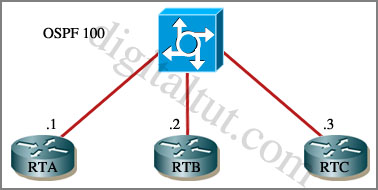 A – RTA will take the place of DR immediately upon establishing its adjacencie
A – RTA will take the place of DR immediately upon establishing its adjacencie
B – RTA will take the place of DR only if RTB fails
C – RTA will take the place of DR only if both RTB and RTC fail
D – A new election will take place establishing an all new DR and BDR based on configured priority levels and MAC addresses
Answer: C
Question 3
Refer to the exhibit. During the process of configuring a virtual link to connect area 2 with the backbone area, the network administrator received this console message on R3:
*Mar 1 00:25:01.084: %OSPF-4-ERRRCV: Received invalid packet: mismatch area ID, from backbone area must be virtual link but not found from 20.20.20.1, Serial 0
How should the virtual link be configured on the OSPF routers to establish full connectivity between the areas?
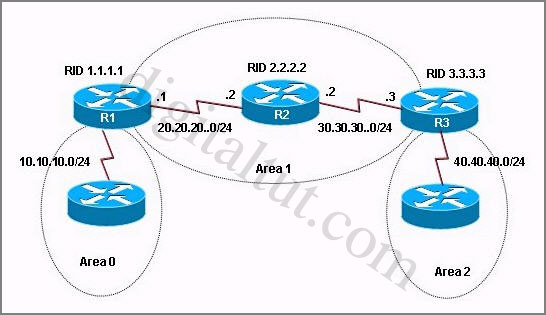 A – R1(config-router)# area 1 virtual-link 30.30.30.3
A – R1(config-router)# area 1 virtual-link 30.30.30.3
R3(config-router)# area 1 virtual-link 20.20.20.1
B – R1(config-router)# area 1 virtual-link 20.20.20.2
R3(config-router)# area 1 virtual-link 30.30.30.2
C – R1(config-router)# area 0 virtual-link 1.1.1.1
R3(config-router)# area 2 virtual-link 3.3.3.3
D – R1(config-router)# area 1 virtual-link 3.3.3.3
R3(config-router)# area 1 virtual-link 1.1.1.1
E – R1(config-router)# area 1 virtual-link 2.2.2.2
R3(config-router)# area 1 virtual-link 2.2.2.2
Answer: D
Explanation
When designing a multi-area OSPF network, all areas should be connected to the backbone area. However, there may be instances when an area will need to cross another area to reach the backbone area like area 2 in this case. A virtual link has the following two requirements:
+ It must be established between two routers that share a common area and are both ABRs.
+ One of these two routers must be connected to the backbone.
In this case, two routers that satisfy the above requirements are R1 and R3. The syntax for creating a virtual link across an area is:
area area-id virtual-link neighbor-router-id
The area-id is the number of the transit area, in this example Area 1 and neighbor-router-id is the IP address of the highest loopback interface configured or can be manually set on the neighboring router.
Question 4
As shown in the exhibit ,OSPF is configured over a Frame Relay network. All PVCs are active. However, ***1 and ***3 fail to see all OSPF routes in their routing tables. The show ip ospf neighbor command executed on ***2 displays the state of the neighbors. In order to fix the problem , what should be done?
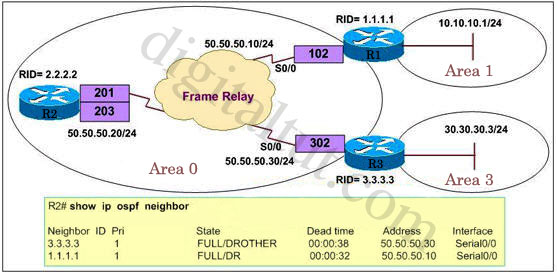 A – The neighbor command should be configured under the OSPF routing process on all routers
A – The neighbor command should be configured under the OSPF routing process on all routers
B – The ip ospf network broadcast command should be configured on each Frame Relay interface
C – The ip ospf network non-broadcast command should be configured on each Frame Relay interface
D – The ip ospf priority value on the spoke routers should be set to 0
Answer: D
Explanation
In an NBMA network topology, neighbors are not discovered automatically. OSPF tries to elect a DR and a BDR due to the multi-access nature of the network, but the election fails since neighbors are not discovered because NBMA environment doesn’t forward broadcast and multicast packets. Neighbors must be configured manually to overcome these problems.
Also, additional configuration is necessary in a hub and spoke topology to make sure that the hub routers, which have connectivity with every other spoke router, are elected as the DR and BDR. You must set the spoke interfaces to an OSPF priority of zero, this ensures that the spokes will not become the DR or BDR.
Question 5
The following exhibit shows ipv6 route output. What would the metric be for a summary route that summarizes all three OSPFv3 routes displayed?
 A – 160
A – 160
B – 140
C – 120
D – 100
Answer: D
Explanation
The cost of the summarized routes is the highest cost of the routes being summarized. In fact, in the old RFC 1583 standard, the cost of the summary route was the cost of the lowest metric. But when OSPF was updated in RFC 2178 and RFC 2328, the summary route should have the same cost as the highest-cost summarized route. In this case, the highest-cost is 100 according to the second entry.
Question 6
Study the exhibit below carefully. In order to summarize all routes from area 0 to area 1, what must be configured on the router?
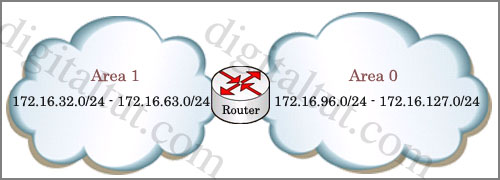
A – area 0 range 172.16.96.0 255.255.224.0
B – area 1 range 172.16.96.0 255.255.224.0
C – area 1 range 172.16.96.0 255.255.0.0
D – area 0 range 172.16.96.0 255.255.255.0
Answer: A
Question 7
Into which two types of areas would an area border router (ABR) inject a default route? (Choose two)
A. the autonomous system of a different interior gateway protocol (IGP)
B. area 0
C. totally stubby
D. NSSA
E. stub
F. the autonomous system of an exterior gateway protocol (EGP)
Answer: C E
Explanation
Both stub area & totally stubby area allow an ABR to inject a default route. The main difference between these 2 types of areas is:
+ Stub area replaces LSA Type 5 (External LSA – created by an ASBR to advertise network from another autonomous system) with a default route
+ Totally stubby area replaces both LSA Type 5 and LSA Type 3 (Summary LSA – created by an ABR to advertise network from other areas, but still within the AS, sometimes called interarea routes) with a default route.
Below summarizes the LSA Types allowed and not allowed in area types:
Question 8
Which three restrictions apply to OSPF stub areas? (Choose three)
A. No virtual links are allowed.
B. The area cannot be a backbone area.
C. Redistribution is not allowed unless the packet is changed to a type 7 packet.
D. The area has no more than 10 routers.
E. No autonomous system border routers are allowed.
F. Interarea routes are suppressed.
Answer: A B E
Question 9
Refer to the partial configurations in the exhibit. What address is utilized for DR and BDR identification on Router1?
A. the serial 1/1 address
B. the serial 2/0 address
C. a randomly generated internal address
D. the configured router-id address
Answer: D
Explanation
In OSPFv3 and OSPF version 2, the router uses the 32-bit IPv4 address to select the router ID for an OSPF process. The router ID selection process for OSPFv3 is described below (same as OSPF version 2):
1. The router ID is used if explicitly configured with the router-id command.
2. Otherwise, the highest IPv4 loopback address is used.
3. Otherwise, the highest active IPv4 address.
4. Otherwise, the router ID must be explicitly configured.
In this case the router ID 10.1.1.3 is explicitly configured -> D is correct.
Question 10
By default, which statement is correct regarding the redistribution of routes from other routing protocols into OSPF?
A. They will appear in the OSPF routing table as type E1 routes.
B. They will appear in the OSPF routing table as type E2 routes.
C. Summarized routes are not accepted.
D. All imported routes will be automatically summarized when possible.
E. Only routes with lower administrative distances will be imported.
Answer: B
Explanation
Type E1 external routes calculate the cost by adding the external cost to the internal cost of each link that the packet crosses while the external cost of E2 packet routes is always the external cost only. E2 is useful if you do not want internal routing to determine the path. E1 is useful when internal routing should be included in path selection. E2 is the default external metric when redistributing routes from other routing protocols into OSPF -> B is correct.
Question 11
Which statement is true about OSPF Network LSAs?
A. They are originated by every router in the OSPF network. They include all routers on the link, interfaces, the cost of the link, and any known neighbor on the link.
B. They are originated by the DR on every multi-access network. They include all attached routers including the DR itself.
C. They are originated by Area Border Routers and are sent into a single area to advertise destinations outside that area.
D. They are originated by Area Border Router and are sent into a single area to advertise an Autonomous System Border Router.
Answer: B
Explanation
Popular LSA Types are listed below:
Question 12
Refer to the exhibit. OSPF is configured on all routers in the network. On the basis of the show ip ospf neighbor output, what prevents R1 from establishing a full adjacency with R2?
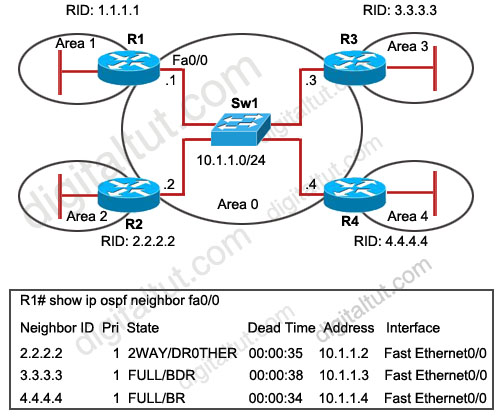
A. Router R1 will only establish full adjacency with the DR and BDR on broadcast multiaccess networks.
B. Router R2 has been elected as a DR for the broadcast multiaccess network in OSPF area
C. Routers R1 and R2 are configured as stub routers for OSPF area 1 and OSPF area 2.
D. Router R1 and R2 are configured for a virtual link between OSPF area 1 and OSPF area 2.
E. The Hello parameters on routers R1 and R2 do not match.
Answer: A
Explanation
From the output, we learn that R4 is the DR and R3 is the BDR so other routers will only establish full adjacency with these routers. All other routers have the two-way adjacency established -> A is correct.
Question 13
Refer to the exhibit. On the basis of the configuration provided, how are the Hello packets sent by R2 handled by R5 in OSPF area 5?
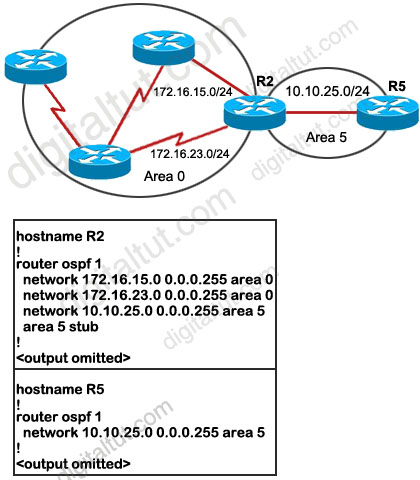
A. The Hello packets will be exchanged and adjacency will be established between routers R2 and R5.
B. The Hello packets will be exchanged but the routers R2 and R5 will become neighbors only.
C. The Hello packets will be dropped and no adjacency will be established between routers R2 and R5.
D. The Hello packets will be dropped but the routers R2 and R5 will become neighbors.
Answer: C
Explanation
Recall that in OSPF, two routers will become neighbors when they agree on the following: Area-id, Authentication, Hello and Dead Intervals, Stub area flag.
We must specify Area 5 as a stub area on the ABR (R2) and all the routers in that area (R5 in this case). But from the output, we learn that only R2 has been configured as a stub for Area 5. This will drop down the neighbor relationship between R2 and R5 because the stub flag is not matched in the Hello packets of these routers.
Question 14
When an OSPF design is planned, which implementation can help a router not have memory resource issues?
A. Have a backbone area (area 0) with 40 routers and use default routes to reach external destinations.
B. Have a backbone area (area 0) with 4 routers and 30,000 external routes injected into OSPF.
C. Have less OSPF areas to reduce the need for interarea route summarizations.
D. Have multiple OSPF processes on each OSPF router. Example, router ospf 1, router ospf 2
Answer: A
Question 15
When verifying the OSPF link state database, which type of LSAs should you expect to see within the different OSPF area types? (Choose three)
A. All OSPF routers in stubby areas can have type 3 LSAs in their database.
B. All OSPF routers in stubby areas can have type 7 LSAs in their database.
C. All OSPF routers in totally stubby areas can have type 3 LSAs in their database.
D. All OSPF routers in totally stubby areas can have type 7 LSAs in their database.
E. All OSPF routers in NSSA areas can have type 3 LSAs in their database.
F. All OSPF routers in NSSA areas can have type 7 LSAs in their database.
Answer: A E F
Explanation
Below summarizes the LSA Types allowed and not allowed in area types:
Popular LSA Types are listed below:
Question 16
You are troubleshooting an OSPF problem where external routes are not showing up in the OSPF database. Which two options are valid checks that should be performed first to verify proper OSPF operation? (Choose two)
A. Are the ASBRs trying to redistribute the external routes into a totally stubby area?
B. Are the ABRs configured with stubby areas?
C. Is the subnets keyword being used with the redistribution command?
D. Is backbone area (area 0) contiguous?
E. Is the CPU utilization of the routers high?
Answer: A C
Explanation
A totally stubby stubby area cannot have an ASBR so it will discard this type of LSA (LSA Type 5) -> A is a valid check.
Each stubby area needs an ABR to communicate with other areas so it is normal -> B is not a valid check.
When pulling routes into OSPF, we need to use the keyword “subnets” so that subnets will be redistributed too. For example, if we redistribute these EIGRP routes into OSPF:
+ 10.0.0.0/8
+ 10.10.0.0/16
+ 10.10.1.0/24
without the keyword “subnets”
router ospf 1
redistribute eigrp 1
Then only 10.0.0.0/8 network will be redistributed because other routes are not classful routes, they are subnets. To redistribute subnets we must use the keyword “subnets”
router ospf 1
redistribute eigrp 1 subnets
-> C is a valid check.
We don’t need to care if area 0 is contiguous or not -> D is not a valid check.
CPU utilization cannot be the cause for this problem -> E is not a valid check.
Question 17
Refer to the exhibit. You are the network administrator responsible for the NProuter, the 10.1.1.1 router, and the 10.1.1.2 router. What can you determine about the OSPF operations from the debug output?
A. The NProuter has two OSPF neighbors in the “Full” adjacency state.
B. The NProuter serial0/0 interface has the OSPF dead timer set to 10 seconds.
C. The NProuter serial0/0 interface has been configured with an OSPF network type of “point-to-point”.
D. The 10.1.1.1 and 10.1.1.2 routers are not using the default OSPF dead and hello timers setting.
E. The “Mismatched” error is caused by the expiration of the OSPF timers.
Answer: B
Explanation
First we should understand clearly about the line
Dead R 120 C 10, Hello R 30 C 30
The “R” here means “Received” and “C” means “Configured”. In other words, “Dead R” is the Dead Timer Received from the neighbor and the “Dead C” is the Dead Timer of the local router.
Therefore in this case “Dead R 120 C 10″ means the Death Timer of the neighbor is 120 seconds while the local Dead Timer is 10 seconds, which causes a mismatch. Also we can learn that the local OSPF dead timer is set to 10 seconds -> B is correct.
For your information, by default, OSPF uses a 10-second hello timer and 40-second hold timer on broadcast and point-to-point links, and a 30-second hello timer and 120-second hold timer for all other network types. So we can’t confirm answer D is correct or not.
Question 18
You have just completed an OSPF implementation. While executing your verification plan, you determine that R1 is not able to establish full OSPF adjacency with R2. The show ip ospf neighbor command output on R1 shows that R2 is stuck in the INIT state.
What could be the cause of this problem?
A. DR and BDR election errors between R1 and R2.
B. The R2 router has not received the OSPF hello packets from the R1 router.
C. Mismatched interface maximum transmission unit (MTU) configuration between the R1 and R2.
D. Mismatched OSPF hello interval configuration between the R1 and R2.
E. Corrupted LSAs exchanges between the R1 and R2.
Answer: B
Explanation
When a router receives an OSPF Hello from a neighbor, it sends the Hello packet by including that neighbor’s router ID in the Hello packet. If the neighbor does not receive this packet (means that it doesn’t see itself in this packet), it will be stuck in INIT state. INIT state can be understood as a one-way Hello. An example of a router stuck in INIT state is shown below:
 Question 19
Question 19
Refer to the exhibit. You have completed an OSPF implementation, and you are verifying OSPF operation. You notice that router A and router B are stuck in the two-way state. From the show ip ospf interface command output, what is the cause of this issue?
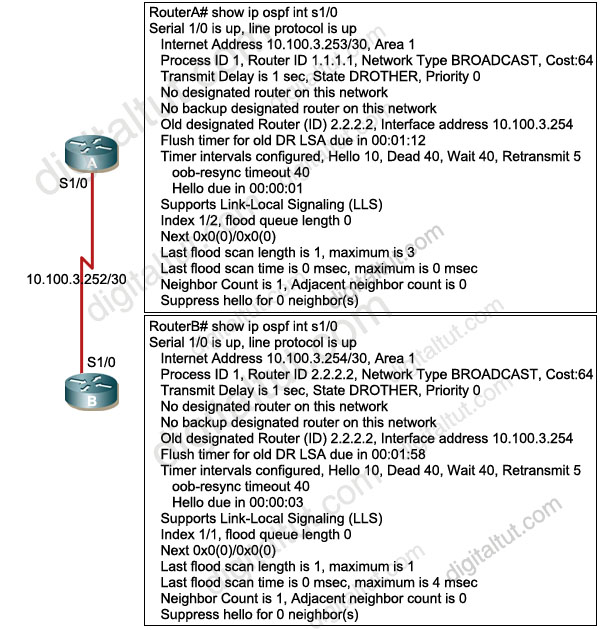 A. All OSPF implementations must have at least one interface in area 0.
A. All OSPF implementations must have at least one interface in area 0.
B. You are attempting to run in the broadcast mode over an NBMA interface.
C. Both routers are configured to function as a BDR; therefore, there is no DR router.
D. Someone has changed the OSPF router ID; therefore you must clear the OSPF process.
E. The OSPF priority is set to 0 on both routers; therefore neither can become the DR.
Answer: E
Explanation
When OSPF adjacency is formed, a router goes through several state changes before it becomes fully adjacent with its neighbor. The states are Down, Attempt, Init, 2-Way, Exstart, Exchange, Loading, and Full.
An OSPF neighbor reaches the 2-way state when bidirectional communication is established (each router has seen the other’s hello packet). This is the beginning of an OSPF adjacency. On broadcast media and non-broadcast multiaccess networks, the DR and BDR are elected in this state. But the priority on both routers are 0 so no DR and BDR are elected -> These routers stay in the 2-way state.
(Reference and a good resource of OSPF Neighbor states: http://www.cisco.com/en/US/tech/tk36...80093f0e.shtml)
Question 20
You have completed an OSPF implementation, and you are verifying OSPF operation. During this verification, you notice that the OSPF route of 172.16.10.0 is repeatedly appearing and disappearing from the routing table. Further investigation finds that the OSPF CPU utilization is very high and the routers are constantly performing SPF calculations. You determine that 172.16.20.2 is the source of the 172.16.10.0 route. Using the show ip ospf database router 172.16.20.1 command, you notice that when this show command is performed repeatedly, the contents of the LSA change every few seconds.
What could be the cause of this problem?
A. OSPF authentication errors between some of the routers.
B. Two routers have the same OSPF router ID.
C. Issues with mistuned OSPF timers.
D. OSPF LSA pacing issues between some of the routers.
E. OSPF neighbor adjacency problems between some of the routers.
Answer: B
Question 21
The maximum number of routers per OSPF area typically depends on which three factors? (Choose three)
A. the kind of OSPF areas being implemented
B. the number of external LSAs in the network
C. the number of DRs and BDRs in the areas
D. the number of virtual links in the areas
E. how well the areas can be summarized
F. the use of LSA filters
Answer: A B E
Explanation
The maximum number of routers per area depends on several factors, including the following:
+ What kind of area do you have?
+ What kind of CPU power do you have in that area?
+ What kind of media?
+ Will you be running OSPF in NBMA mode?
+ Is your NBMA network meshed?
+ Do you have a lot of external LSAs in the network?
+ Are other areas well summarized?
Question 22
When verifying OSPF virtual link problems, which is an important item to check on the two transit OSPF routers?
A. OSPF process ID
B. OSPF router ID
C. OSPF network type
D. OSPF memory usage
E. OSPF CPU utilization
F. OSPF stub area configurations
Answer: B
Explanation
The OSPF router IDs of the two transit OSPF routers are used to form the virtual link (with the area area-id virtual-link neighbor-router-id command) so it is an important item to check -> B is correct.
Question 23
The administrator wants to verify the current state of the OSPF database loading process.
Which show command should the administrator use?
A. show ip ospf [process-id] interface
B. show ip ospf neighbor
C. show ip ospf [process-id]
D. show ip ospf [process-id area-id] database
Answer: B
Explanation
The “show ip ospf neighbor” command can be used to view the current state of the OSPF database loading process. In the output below we can see router 2.2.2.2 is in 2way state, router 3.3.3.3 is elected as the BDR & router 4.4.4.4 is the BR.

Question 24
Which two statements about route redistribution when implementing OSPF are true? (Choose two)
A. Routes learned using any IP routing protocol can only be redistributed into non IP routing protocols.
B. OSPF can import routes learned using EIGRP, RIP, and IS-IS.
C. OSPF routes cannot be exported into EIGRP, RIP, and IS-IS.
D. At the interdomain level, OSPF cannot import routes learned using BGP.
E. OSPF routes can be exported into BGP.
Answer: B E
Question 25
An administrator types in the command router ospf 1 and receives the error message: “OSPF process 1 cannot start.” (Output is omitted.)
What should be done to correctly set up OSPF?
A. Ensure that an interface has been configured with an IP address.
B. Ensure that an interface has been configured with an IP address and is up.
C. Ensure that IP classless is enabled.
D. Ensure that the interfaces can ping their directly connected neighbors.
Answer: B
Explanation
OSPF can be only started when there is at least one interface up and configured with an IP address on the router.
Question 26
Which three are advantages to creating multiple areas in OSPF? (Choose three)
A. less frequent SPF calculations
B. fewer hello packets
C. smaller routing tables
D. reduced LSU overhead
E. fewer adjacencies needed
Answer: A C D
Explanation
OSPF routers within an area only need to know about other routers within their own area, not outside their area, and all OSPF routers within a given area share the same link state database. This keeps the routing tables small enough to prevent processing bottlenecks from occurring -> C is correct.
Also SPF only needs to calculate paths to routers within that area -> A is correct.
If a router receives an LSA with old information then it will send a LSU to the sender to update the sender with the newer information. The Link State Update (LSU) holds the LSAs. Instead of sending multiple LSUs the ABR / ASBR summarizes a route and sends only one LSU-> D is correct.
Note: The LSA has a 30 minute timer that causes the router to send an LSU to everyone on the network once it ages out.
Question 27
Refer to the exhibit. Two routers are connected by Frame Relay and are running OSPF between them. Each router has been configured with the appropriate network statements under router ospf 1, but the routers are not forming an adjacency. Which of the following three commands could be configured on each router to correct this problem? (Choose three)
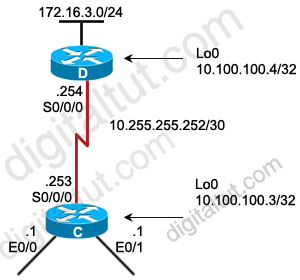 A.
A.
RouterC(config-if )#ip ospf network broadcast
RouterD(config-if )#ip ospf network broadcast
B.
RouterC(config-if)#ip ospf network point-to-point
RouterD(config-if)#ip ospf network point-to-point
C.
RouterC(config-router)#neighbor 10.100.100.4
RouterD(config-router)#neighbor 10.100.100.3
D.
RouterC(config-router)#neighbor 10.255.255.254
RouterD(config-router)#neighbor 10.255.255.253
Answer: A B D
Explanation
By default, Frame Relay is classified as a non-broadcast network, meaning it doesn’t send any broadcasts/multicasts like RIP, OSPF or EIGRP updates across the network (hello packets of OSPF are multicast to 224.0.0.5). Hence, in NBMA network, the neighbors are not discovered automatically; they must be configured manually. There are two ways to simulate a broadcast model on an NBMA network:
+ Define the network type as broadcast with the “ip ospf network broadcast” interface sub-command
+ Configure the neighbor statements under router ospf mode (though configuring the neighbor statement on one end is sufficient to form adjacency, it is a good practice to have it configured on both the ends)
Besides these two ways, another way for making OSPF work with Frame Relay is configuring the network as a Point-to-Point network (or Point-to-Multipoint, notice that OSPF treats Point-to-Multipoint network as a collective of point-to-point links).
Some information about Point-to-Multipoint (or Point-to-Point) network:
Note: Point-to-Multipoint networks do not maintain a DR/BDR relationship.
Question 28
Refer to the exhibit. What is the effect of the OSPF configuration on router B?
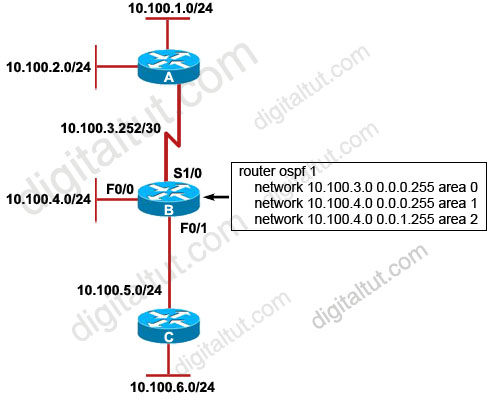
A. All interfaces will be in area 0.
B. The router will be an ABR with s1/0 in area 0 and 0/0 and 0/1 in area 1.
C. The router will be an ABR with s1/0 in area 0 and 0/0 and 0/1 in area 2.
D. The router will be an ABR with s1/0 in area 0, f0/0 in area 1, and f0/1 in area 2.
Answer: D
Question 29
OSPF is enabled on router A. You execute the following command on router A and receive the accompanying output:
10.100.100.1 is the IP address of a loopback interface on router A. What can you conclude about router A?
A. Only the router A loopback interface is participating in the OSPF routing process.
B. None of the router A interfaces are participating in the OSPF routing process.
C. Router A is using the loopback interface IP address as its OSPF router ID.
D. Router A does not have any reachable OSPF neighbors.
Answer: D
Explanation
The 224.0.0.5 address is the multicast for OSPF routers. Therefore when you ping to this address all the interfaces running OSPF will reply but from the output we learn that only the local router responded -> Router A does not have any reachable OSPF neighbors -> D is correct.
Question 30
Your network has a mixture of Fast Ethernet and Gigabit Ethernet links. What needs to be done to ensure optimal data routing when using OSPF?
A. Nothing. OSPF will determine the most optimal path for routing data by default.
B. Adjust the hello and dead timers for more rapid detection of link failures.
C. Increase the reference-bandwidth used to calculate the interface default metrics, on all routers in your network.
D. Set the priority values on every broadcast interface to ensure that the designated and backup designated routers are the routers with the most processor and memory resources.
Answer: C
Explanation
The default formula to calculate the cost for the OSPF metric is (108/BW). Therefore when using default reference bandwidth (100M) to calculate ospf, Gi and Fa interfaces could have the same cost (1). This problem can be fixed by configuring reference bandwidth to 1000M.
This is how to configure reference bandwidth to 1000Mbps:
Router(config)#router ospf 1
Router(config-router)#auto-cost reference-bandwidth 1000
An administrator Pipes in the command router ospf 1 and receives the error message: “OSPF process 1 cannot start.” (Output is omitted.) What should be done to correctly set up OSPF?
A – Ensure that an interface has been configured with an IP address
B – Ensure that an interface has been configured with an IP address and is up
C – Ensure that IP classless is enabled
D – Ensure that the interfaces can ping their directly connected neighbors
Answer: B
Question 2
During a recent OSPF election among three routers. RTA was elected the DR and RTB was elected the BDR, as seen in the graphic. Assume that RTA fails, and that RTB takes the place of the DR while RTC becomes the new BDR. What will happen when RTA comes back online?

B – RTA will take the place of DR only if RTB fails
C – RTA will take the place of DR only if both RTB and RTC fail
D – A new election will take place establishing an all new DR and BDR based on configured priority levels and MAC addresses
Answer: C
Question 3
Refer to the exhibit. During the process of configuring a virtual link to connect area 2 with the backbone area, the network administrator received this console message on R3:
*Mar 1 00:25:01.084: %OSPF-4-ERRRCV: Received invalid packet: mismatch area ID, from backbone area must be virtual link but not found from 20.20.20.1, Serial 0
How should the virtual link be configured on the OSPF routers to establish full connectivity between the areas?

R3(config-router)# area 1 virtual-link 20.20.20.1
B – R1(config-router)# area 1 virtual-link 20.20.20.2
R3(config-router)# area 1 virtual-link 30.30.30.2
C – R1(config-router)# area 0 virtual-link 1.1.1.1
R3(config-router)# area 2 virtual-link 3.3.3.3
D – R1(config-router)# area 1 virtual-link 3.3.3.3
R3(config-router)# area 1 virtual-link 1.1.1.1
E – R1(config-router)# area 1 virtual-link 2.2.2.2
R3(config-router)# area 1 virtual-link 2.2.2.2
Answer: D
Explanation
When designing a multi-area OSPF network, all areas should be connected to the backbone area. However, there may be instances when an area will need to cross another area to reach the backbone area like area 2 in this case. A virtual link has the following two requirements:
+ It must be established between two routers that share a common area and are both ABRs.
+ One of these two routers must be connected to the backbone.
In this case, two routers that satisfy the above requirements are R1 and R3. The syntax for creating a virtual link across an area is:
area area-id virtual-link neighbor-router-id
The area-id is the number of the transit area, in this example Area 1 and neighbor-router-id is the IP address of the highest loopback interface configured or can be manually set on the neighboring router.
Question 4
As shown in the exhibit ,OSPF is configured over a Frame Relay network. All PVCs are active. However, ***1 and ***3 fail to see all OSPF routes in their routing tables. The show ip ospf neighbor command executed on ***2 displays the state of the neighbors. In order to fix the problem , what should be done?

B – The ip ospf network broadcast command should be configured on each Frame Relay interface
C – The ip ospf network non-broadcast command should be configured on each Frame Relay interface
D – The ip ospf priority value on the spoke routers should be set to 0
Answer: D
Explanation
In an NBMA network topology, neighbors are not discovered automatically. OSPF tries to elect a DR and a BDR due to the multi-access nature of the network, but the election fails since neighbors are not discovered because NBMA environment doesn’t forward broadcast and multicast packets. Neighbors must be configured manually to overcome these problems.
Also, additional configuration is necessary in a hub and spoke topology to make sure that the hub routers, which have connectivity with every other spoke router, are elected as the DR and BDR. You must set the spoke interfaces to an OSPF priority of zero, this ensures that the spokes will not become the DR or BDR.
Question 5
The following exhibit shows ipv6 route output. What would the metric be for a summary route that summarizes all three OSPFv3 routes displayed?

B – 140
C – 120
D – 100
Answer: D
Explanation
The cost of the summarized routes is the highest cost of the routes being summarized. In fact, in the old RFC 1583 standard, the cost of the summary route was the cost of the lowest metric. But when OSPF was updated in RFC 2178 and RFC 2328, the summary route should have the same cost as the highest-cost summarized route. In this case, the highest-cost is 100 according to the second entry.
Question 6
Study the exhibit below carefully. In order to summarize all routes from area 0 to area 1, what must be configured on the router?

B – area 1 range 172.16.96.0 255.255.224.0
C – area 1 range 172.16.96.0 255.255.0.0
D – area 0 range 172.16.96.0 255.255.255.0
Answer: A
Question 7
Into which two types of areas would an area border router (ABR) inject a default route? (Choose two)
A. the autonomous system of a different interior gateway protocol (IGP)
B. area 0
C. totally stubby
D. NSSA
E. stub
F. the autonomous system of an exterior gateway protocol (EGP)
Answer: C E
Explanation
Both stub area & totally stubby area allow an ABR to inject a default route. The main difference between these 2 types of areas is:
+ Stub area replaces LSA Type 5 (External LSA – created by an ASBR to advertise network from another autonomous system) with a default route
+ Totally stubby area replaces both LSA Type 5 and LSA Type 3 (Summary LSA – created by an ABR to advertise network from other areas, but still within the AS, sometimes called interarea routes) with a default route.
Below summarizes the LSA Types allowed and not allowed in area types:
| Area Type | Type 1 & 2 (within area) | Type 3 (from other areas) | Type 4 | Type 5 | Type 7 |
| Standard & backbone | Yes | Yes | Yes | Yes | No |
| Stub | Yes | Yes | No | No | No |
| Totally stubby | Yes | No | No | No | No |
| NSSA | Yes | Yes | No | No | Yes |
| Totally stubby NSSA | Yes | No | No | No | Yes |
Which three restrictions apply to OSPF stub areas? (Choose three)
A. No virtual links are allowed.
B. The area cannot be a backbone area.
C. Redistribution is not allowed unless the packet is changed to a type 7 packet.
D. The area has no more than 10 routers.
E. No autonomous system border routers are allowed.
F. Interarea routes are suppressed.
Answer: A B E
Question 9
Refer to the partial configurations in the exhibit. What address is utilized for DR and BDR identification on Router1?
| Router1#show run **** output omitted ****** interface serial1/1 ipv6 address 2001:410:FFFE:1::64/64 ipv6 ospf 100 area 0 ! interface serial2/0 ipv6 address 3FFF:B00:FFFF:1::2/64 ipv6 ospf 100 area 0 ! ipv6 router ospf router-id 10.1.1.3 |
B. the serial 2/0 address
C. a randomly generated internal address
D. the configured router-id address
Answer: D
Explanation
In OSPFv3 and OSPF version 2, the router uses the 32-bit IPv4 address to select the router ID for an OSPF process. The router ID selection process for OSPFv3 is described below (same as OSPF version 2):
1. The router ID is used if explicitly configured with the router-id command.
2. Otherwise, the highest IPv4 loopback address is used.
3. Otherwise, the highest active IPv4 address.
4. Otherwise, the router ID must be explicitly configured.
In this case the router ID 10.1.1.3 is explicitly configured -> D is correct.
Question 10
By default, which statement is correct regarding the redistribution of routes from other routing protocols into OSPF?
A. They will appear in the OSPF routing table as type E1 routes.
B. They will appear in the OSPF routing table as type E2 routes.
C. Summarized routes are not accepted.
D. All imported routes will be automatically summarized when possible.
E. Only routes with lower administrative distances will be imported.
Answer: B
Explanation
Type E1 external routes calculate the cost by adding the external cost to the internal cost of each link that the packet crosses while the external cost of E2 packet routes is always the external cost only. E2 is useful if you do not want internal routing to determine the path. E1 is useful when internal routing should be included in path selection. E2 is the default external metric when redistributing routes from other routing protocols into OSPF -> B is correct.
Question 11
Which statement is true about OSPF Network LSAs?
A. They are originated by every router in the OSPF network. They include all routers on the link, interfaces, the cost of the link, and any known neighbor on the link.
B. They are originated by the DR on every multi-access network. They include all attached routers including the DR itself.
C. They are originated by Area Border Routers and are sent into a single area to advertise destinations outside that area.
D. They are originated by Area Border Router and are sent into a single area to advertise an Autonomous System Border Router.
Answer: B
Explanation
Popular LSA Types are listed below:
| LSA Type | Description | Details |
| 1 | Router LSA | Generated by all routers in an area to describe their directly attached links |
| 2 | Network LSA | Advertised by the DR of the broadcast network (does not cross ABR) |
| 3 | Summary LSA | Advertised by the ABR of originating area |
| 4 | Summary LSA | Generated by the ABR of the originating area to advertise an ASBR to all other areas in the autonomous system |
| 5 | AS external LSA | Used by the ASBR to advertise networks from other autonomous systems |
| 7 | Defined for NSSAs | Generated by an ASBR inside a Not-so-stubby area (NSSA) to describe routes redistributed into the NSSA |
Refer to the exhibit. OSPF is configured on all routers in the network. On the basis of the show ip ospf neighbor output, what prevents R1 from establishing a full adjacency with R2?

B. Router R2 has been elected as a DR for the broadcast multiaccess network in OSPF area
C. Routers R1 and R2 are configured as stub routers for OSPF area 1 and OSPF area 2.
D. Router R1 and R2 are configured for a virtual link between OSPF area 1 and OSPF area 2.
E. The Hello parameters on routers R1 and R2 do not match.
Answer: A
Explanation
From the output, we learn that R4 is the DR and R3 is the BDR so other routers will only establish full adjacency with these routers. All other routers have the two-way adjacency established -> A is correct.
Question 13
Refer to the exhibit. On the basis of the configuration provided, how are the Hello packets sent by R2 handled by R5 in OSPF area 5?

B. The Hello packets will be exchanged but the routers R2 and R5 will become neighbors only.
C. The Hello packets will be dropped and no adjacency will be established between routers R2 and R5.
D. The Hello packets will be dropped but the routers R2 and R5 will become neighbors.
Answer: C
Explanation
Recall that in OSPF, two routers will become neighbors when they agree on the following: Area-id, Authentication, Hello and Dead Intervals, Stub area flag.
We must specify Area 5 as a stub area on the ABR (R2) and all the routers in that area (R5 in this case). But from the output, we learn that only R2 has been configured as a stub for Area 5. This will drop down the neighbor relationship between R2 and R5 because the stub flag is not matched in the Hello packets of these routers.
Question 14
When an OSPF design is planned, which implementation can help a router not have memory resource issues?
A. Have a backbone area (area 0) with 40 routers and use default routes to reach external destinations.
B. Have a backbone area (area 0) with 4 routers and 30,000 external routes injected into OSPF.
C. Have less OSPF areas to reduce the need for interarea route summarizations.
D. Have multiple OSPF processes on each OSPF router. Example, router ospf 1, router ospf 2
Answer: A
Question 15
When verifying the OSPF link state database, which type of LSAs should you expect to see within the different OSPF area types? (Choose three)
A. All OSPF routers in stubby areas can have type 3 LSAs in their database.
B. All OSPF routers in stubby areas can have type 7 LSAs in their database.
C. All OSPF routers in totally stubby areas can have type 3 LSAs in their database.
D. All OSPF routers in totally stubby areas can have type 7 LSAs in their database.
E. All OSPF routers in NSSA areas can have type 3 LSAs in their database.
F. All OSPF routers in NSSA areas can have type 7 LSAs in their database.
Answer: A E F
Explanation
Below summarizes the LSA Types allowed and not allowed in area types:
| Area Type | Type 1 & 2 (within area) | Type 3 (from other areas) | Type 4 | Type 5 | Type 7 |
| Standard & backbone | Yes | Yes | Yes | Yes | No |
| Stub | Yes | Yes | No | No | No |
| Totally stubby | Yes | No | No | No | No |
| NSSA | Yes | Yes | No | No | Yes |
| Totally stubby NSSA | Yes | No | No | No | Yes |
| LSA Type | Description | Details |
| 1 | Router LSA | Generated by all routers in an area to describe their directly attached links |
| 2 | Network LSA | Advertised by the DR of the broadcast network (does not cross ABR) |
| 3 | Summary LSA | Advertised by the ABR of originating area |
| 4 | Summary LSA | Generated by the ABR of the originating area to advertise an ASBR to all other areas in the autonomous system |
| 5 | AS external LSA | Used by the ASBR to advertise networks from other autonomous systems |
| 7 | Defined for NSSAs | Generated by an ASBR inside a Not-so-stubby area (NSSA) to describe routes redistributed into the NSSA |
You are troubleshooting an OSPF problem where external routes are not showing up in the OSPF database. Which two options are valid checks that should be performed first to verify proper OSPF operation? (Choose two)
A. Are the ASBRs trying to redistribute the external routes into a totally stubby area?
B. Are the ABRs configured with stubby areas?
C. Is the subnets keyword being used with the redistribution command?
D. Is backbone area (area 0) contiguous?
E. Is the CPU utilization of the routers high?
Answer: A C
Explanation
A totally stubby stubby area cannot have an ASBR so it will discard this type of LSA (LSA Type 5) -> A is a valid check.
Each stubby area needs an ABR to communicate with other areas so it is normal -> B is not a valid check.
When pulling routes into OSPF, we need to use the keyword “subnets” so that subnets will be redistributed too. For example, if we redistribute these EIGRP routes into OSPF:
+ 10.0.0.0/8
+ 10.10.0.0/16
+ 10.10.1.0/24
without the keyword “subnets”
router ospf 1
redistribute eigrp 1
Then only 10.0.0.0/8 network will be redistributed because other routes are not classful routes, they are subnets. To redistribute subnets we must use the keyword “subnets”
router ospf 1
redistribute eigrp 1 subnets
-> C is a valid check.
We don’t need to care if area 0 is contiguous or not -> D is not a valid check.
CPU utilization cannot be the cause for this problem -> E is not a valid check.
Question 17
Refer to the exhibit. You are the network administrator responsible for the NProuter, the 10.1.1.1 router, and the 10.1.1.2 router. What can you determine about the OSPF operations from the debug output?
| NProuter#debug ip ospf events OSPF events debugging is on NProuter# 00:02:03: OSPF: Rev hello from 172.16.1.1 area 0 from Serial0/0 10.1.1.1 00:02:03: OSPF: Mismatched hello parameter from 10.1.1.1 00:02:03: OSPF: Dead R 120 C 10, Hello R 30 C 30 00:02:26: OSPF’ Rcv hello from 192.168.1.2 area 0 from Serial0/0 10.1.1.2 00:02:26: OSPF: Mismatched hello parameters from 10.1.1.2 00:02:26: OSPF: Dead R 120 C 10, Hello R 30 C 30 |
B. The NProuter serial0/0 interface has the OSPF dead timer set to 10 seconds.
C. The NProuter serial0/0 interface has been configured with an OSPF network type of “point-to-point”.
D. The 10.1.1.1 and 10.1.1.2 routers are not using the default OSPF dead and hello timers setting.
E. The “Mismatched” error is caused by the expiration of the OSPF timers.
Answer: B
Explanation
First we should understand clearly about the line
Dead R 120 C 10, Hello R 30 C 30
The “R” here means “Received” and “C” means “Configured”. In other words, “Dead R” is the Dead Timer Received from the neighbor and the “Dead C” is the Dead Timer of the local router.
Therefore in this case “Dead R 120 C 10″ means the Death Timer of the neighbor is 120 seconds while the local Dead Timer is 10 seconds, which causes a mismatch. Also we can learn that the local OSPF dead timer is set to 10 seconds -> B is correct.
For your information, by default, OSPF uses a 10-second hello timer and 40-second hold timer on broadcast and point-to-point links, and a 30-second hello timer and 120-second hold timer for all other network types. So we can’t confirm answer D is correct or not.
Question 18
You have just completed an OSPF implementation. While executing your verification plan, you determine that R1 is not able to establish full OSPF adjacency with R2. The show ip ospf neighbor command output on R1 shows that R2 is stuck in the INIT state.
What could be the cause of this problem?
A. DR and BDR election errors between R1 and R2.
B. The R2 router has not received the OSPF hello packets from the R1 router.
C. Mismatched interface maximum transmission unit (MTU) configuration between the R1 and R2.
D. Mismatched OSPF hello interval configuration between the R1 and R2.
E. Corrupted LSAs exchanges between the R1 and R2.
Answer: B
Explanation
When a router receives an OSPF Hello from a neighbor, it sends the Hello packet by including that neighbor’s router ID in the Hello packet. If the neighbor does not receive this packet (means that it doesn’t see itself in this packet), it will be stuck in INIT state. INIT state can be understood as a one-way Hello. An example of a router stuck in INIT state is shown below:

Refer to the exhibit. You have completed an OSPF implementation, and you are verifying OSPF operation. You notice that router A and router B are stuck in the two-way state. From the show ip ospf interface command output, what is the cause of this issue?

B. You are attempting to run in the broadcast mode over an NBMA interface.
C. Both routers are configured to function as a BDR; therefore, there is no DR router.
D. Someone has changed the OSPF router ID; therefore you must clear the OSPF process.
E. The OSPF priority is set to 0 on both routers; therefore neither can become the DR.
Answer: E
Explanation
When OSPF adjacency is formed, a router goes through several state changes before it becomes fully adjacent with its neighbor. The states are Down, Attempt, Init, 2-Way, Exstart, Exchange, Loading, and Full.
An OSPF neighbor reaches the 2-way state when bidirectional communication is established (each router has seen the other’s hello packet). This is the beginning of an OSPF adjacency. On broadcast media and non-broadcast multiaccess networks, the DR and BDR are elected in this state. But the priority on both routers are 0 so no DR and BDR are elected -> These routers stay in the 2-way state.
(Reference and a good resource of OSPF Neighbor states: http://www.cisco.com/en/US/tech/tk36...80093f0e.shtml)
Question 20
You have completed an OSPF implementation, and you are verifying OSPF operation. During this verification, you notice that the OSPF route of 172.16.10.0 is repeatedly appearing and disappearing from the routing table. Further investigation finds that the OSPF CPU utilization is very high and the routers are constantly performing SPF calculations. You determine that 172.16.20.2 is the source of the 172.16.10.0 route. Using the show ip ospf database router 172.16.20.1 command, you notice that when this show command is performed repeatedly, the contents of the LSA change every few seconds.
What could be the cause of this problem?
A. OSPF authentication errors between some of the routers.
B. Two routers have the same OSPF router ID.
C. Issues with mistuned OSPF timers.
D. OSPF LSA pacing issues between some of the routers.
E. OSPF neighbor adjacency problems between some of the routers.
Answer: B
Question 21
The maximum number of routers per OSPF area typically depends on which three factors? (Choose three)
A. the kind of OSPF areas being implemented
B. the number of external LSAs in the network
C. the number of DRs and BDRs in the areas
D. the number of virtual links in the areas
E. how well the areas can be summarized
F. the use of LSA filters
Answer: A B E
Explanation
The maximum number of routers per area depends on several factors, including the following:
+ What kind of area do you have?
+ What kind of CPU power do you have in that area?
+ What kind of media?
+ Will you be running OSPF in NBMA mode?
+ Is your NBMA network meshed?
+ Do you have a lot of external LSAs in the network?
+ Are other areas well summarized?
Question 22
When verifying OSPF virtual link problems, which is an important item to check on the two transit OSPF routers?
A. OSPF process ID
B. OSPF router ID
C. OSPF network type
D. OSPF memory usage
E. OSPF CPU utilization
F. OSPF stub area configurations
Answer: B
Explanation
The OSPF router IDs of the two transit OSPF routers are used to form the virtual link (with the area area-id virtual-link neighbor-router-id command) so it is an important item to check -> B is correct.
Question 23
The administrator wants to verify the current state of the OSPF database loading process.
Which show command should the administrator use?
A. show ip ospf [process-id] interface
B. show ip ospf neighbor
C. show ip ospf [process-id]
D. show ip ospf [process-id area-id] database
Answer: B
Explanation
The “show ip ospf neighbor” command can be used to view the current state of the OSPF database loading process. In the output below we can see router 2.2.2.2 is in 2way state, router 3.3.3.3 is elected as the BDR & router 4.4.4.4 is the BR.

Question 24
Which two statements about route redistribution when implementing OSPF are true? (Choose two)
A. Routes learned using any IP routing protocol can only be redistributed into non IP routing protocols.
B. OSPF can import routes learned using EIGRP, RIP, and IS-IS.
C. OSPF routes cannot be exported into EIGRP, RIP, and IS-IS.
D. At the interdomain level, OSPF cannot import routes learned using BGP.
E. OSPF routes can be exported into BGP.
Answer: B E
Question 25
An administrator types in the command router ospf 1 and receives the error message: “OSPF process 1 cannot start.” (Output is omitted.)
What should be done to correctly set up OSPF?
A. Ensure that an interface has been configured with an IP address.
B. Ensure that an interface has been configured with an IP address and is up.
C. Ensure that IP classless is enabled.
D. Ensure that the interfaces can ping their directly connected neighbors.
Answer: B
Explanation
OSPF can be only started when there is at least one interface up and configured with an IP address on the router.
Question 26
Which three are advantages to creating multiple areas in OSPF? (Choose three)
A. less frequent SPF calculations
B. fewer hello packets
C. smaller routing tables
D. reduced LSU overhead
E. fewer adjacencies needed
Answer: A C D
Explanation
OSPF routers within an area only need to know about other routers within their own area, not outside their area, and all OSPF routers within a given area share the same link state database. This keeps the routing tables small enough to prevent processing bottlenecks from occurring -> C is correct.
Also SPF only needs to calculate paths to routers within that area -> A is correct.
If a router receives an LSA with old information then it will send a LSU to the sender to update the sender with the newer information. The Link State Update (LSU) holds the LSAs. Instead of sending multiple LSUs the ABR / ASBR summarizes a route and sends only one LSU-> D is correct.
Note: The LSA has a 30 minute timer that causes the router to send an LSU to everyone on the network once it ages out.
Question 27
Refer to the exhibit. Two routers are connected by Frame Relay and are running OSPF between them. Each router has been configured with the appropriate network statements under router ospf 1, but the routers are not forming an adjacency. Which of the following three commands could be configured on each router to correct this problem? (Choose three)

RouterC(config-if )#ip ospf network broadcast
RouterD(config-if )#ip ospf network broadcast
B.
RouterC(config-if)#ip ospf network point-to-point
RouterD(config-if)#ip ospf network point-to-point
C.
RouterC(config-router)#neighbor 10.100.100.4
RouterD(config-router)#neighbor 10.100.100.3
D.
RouterC(config-router)#neighbor 10.255.255.254
RouterD(config-router)#neighbor 10.255.255.253
Answer: A B D
Explanation
By default, Frame Relay is classified as a non-broadcast network, meaning it doesn’t send any broadcasts/multicasts like RIP, OSPF or EIGRP updates across the network (hello packets of OSPF are multicast to 224.0.0.5). Hence, in NBMA network, the neighbors are not discovered automatically; they must be configured manually. There are two ways to simulate a broadcast model on an NBMA network:
+ Define the network type as broadcast with the “ip ospf network broadcast” interface sub-command
+ Configure the neighbor statements under router ospf mode (though configuring the neighbor statement on one end is sufficient to form adjacency, it is a good practice to have it configured on both the ends)
Besides these two ways, another way for making OSPF work with Frame Relay is configuring the network as a Point-to-Point network (or Point-to-Multipoint, notice that OSPF treats Point-to-Multipoint network as a collective of point-to-point links).
Some information about Point-to-Multipoint (or Point-to-Point) network:
Note: Point-to-Multipoint networks do not maintain a DR/BDR relationship.
Question 28
Refer to the exhibit. What is the effect of the OSPF configuration on router B?

B. The router will be an ABR with s1/0 in area 0 and 0/0 and 0/1 in area 1.
C. The router will be an ABR with s1/0 in area 0 and 0/0 and 0/1 in area 2.
D. The router will be an ABR with s1/0 in area 0, f0/0 in area 1, and f0/1 in area 2.
Answer: D
Question 29
OSPF is enabled on router A. You execute the following command on router A and receive the accompanying output:
| RouterA#ping 224.0.0.5 repeat 1 Type escape sequence to abort. Sending 1, 100-byte ICMP Echos to 224.0.0.5, timeout is 2 seconds: Reply to request 0 from 10.100.100.1, 4 ms |
A. Only the router A loopback interface is participating in the OSPF routing process.
B. None of the router A interfaces are participating in the OSPF routing process.
C. Router A is using the loopback interface IP address as its OSPF router ID.
D. Router A does not have any reachable OSPF neighbors.
Answer: D
Explanation
The 224.0.0.5 address is the multicast for OSPF routers. Therefore when you ping to this address all the interfaces running OSPF will reply but from the output we learn that only the local router responded -> Router A does not have any reachable OSPF neighbors -> D is correct.
Question 30
Your network has a mixture of Fast Ethernet and Gigabit Ethernet links. What needs to be done to ensure optimal data routing when using OSPF?
A. Nothing. OSPF will determine the most optimal path for routing data by default.
B. Adjust the hello and dead timers for more rapid detection of link failures.
C. Increase the reference-bandwidth used to calculate the interface default metrics, on all routers in your network.
D. Set the priority values on every broadcast interface to ensure that the designated and backup designated routers are the routers with the most processor and memory resources.
Answer: C
Explanation
The default formula to calculate the cost for the OSPF metric is (108/BW). Therefore when using default reference bandwidth (100M) to calculate ospf, Gi and Fa interfaces could have the same cost (1). This problem can be fixed by configuring reference bandwidth to 1000M.
| Default Bandwidth (100M) | Configured Bandwidth (1000M) |
| Fa = 100M / 100M = 1 Gi = 100M / 1000M = 0.1 -> round up to 1 |
Fa = 1000M / 100M = 10 Gi = 1000M / 1000M = 1 |
Router(config)#router ospf 1
Router(config-router)#auto-cost reference-bandwidth 1000

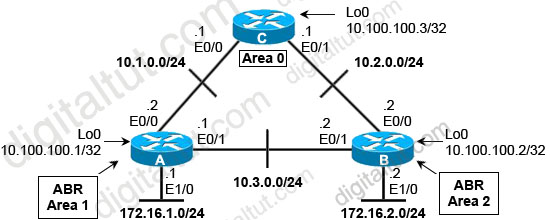
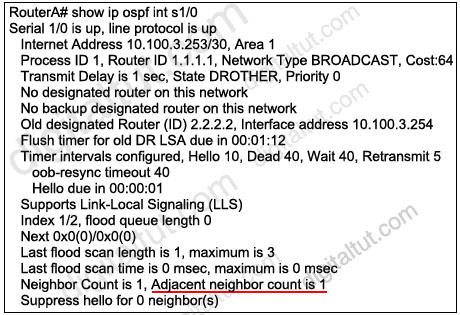
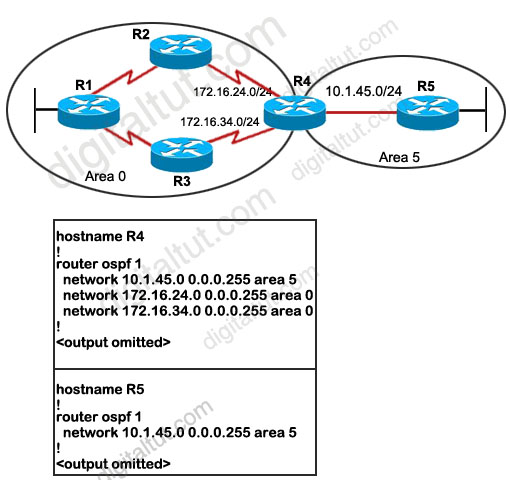
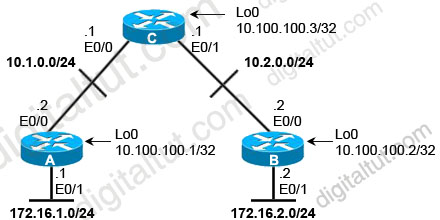
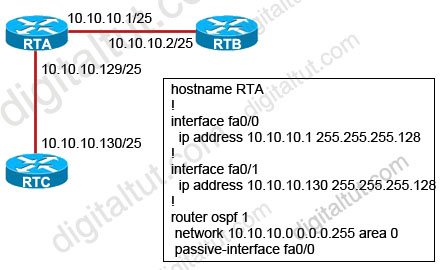
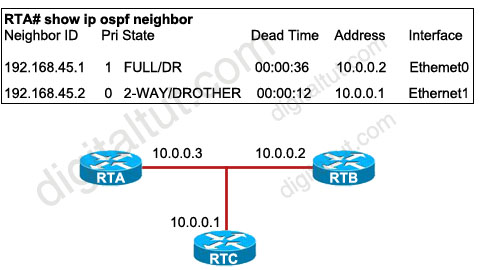
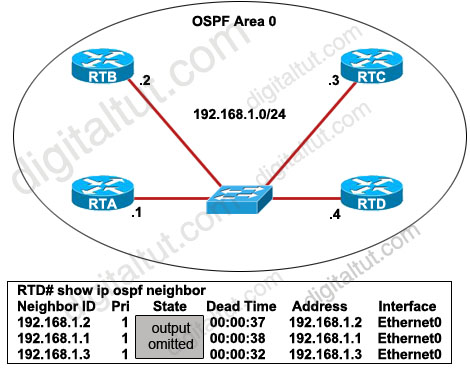
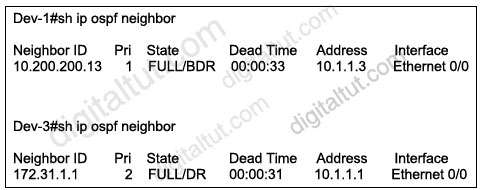
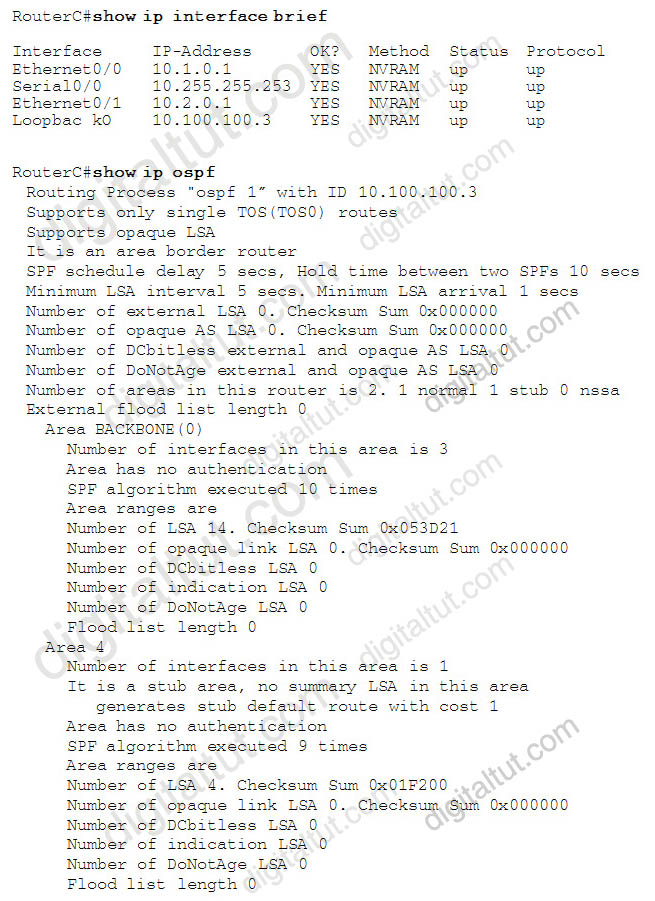
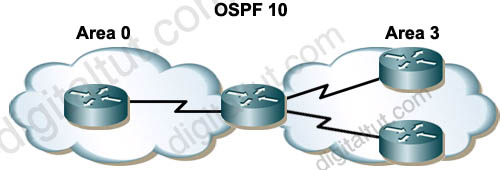
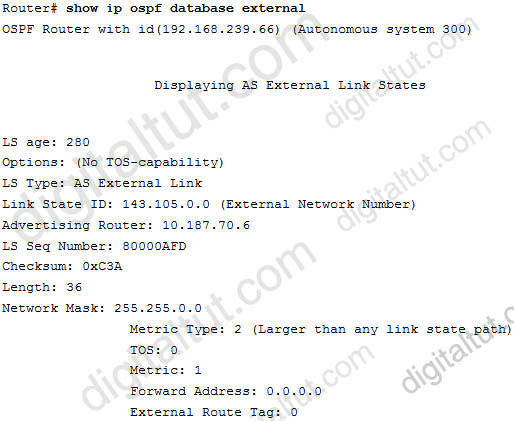
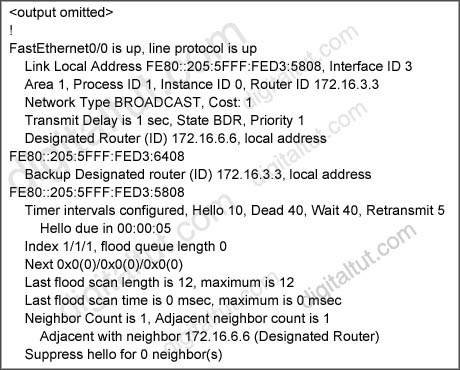
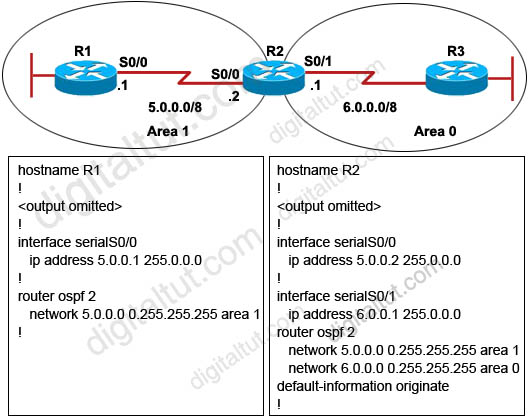
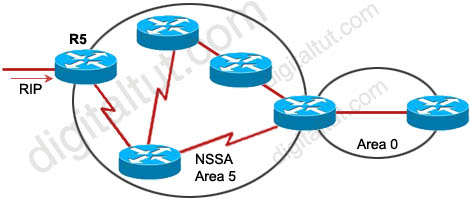
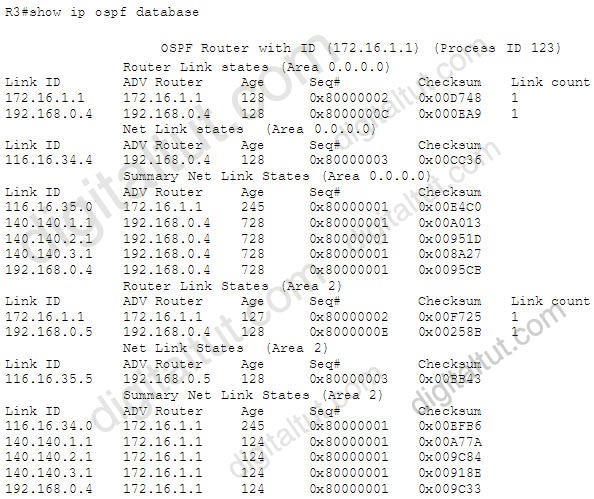
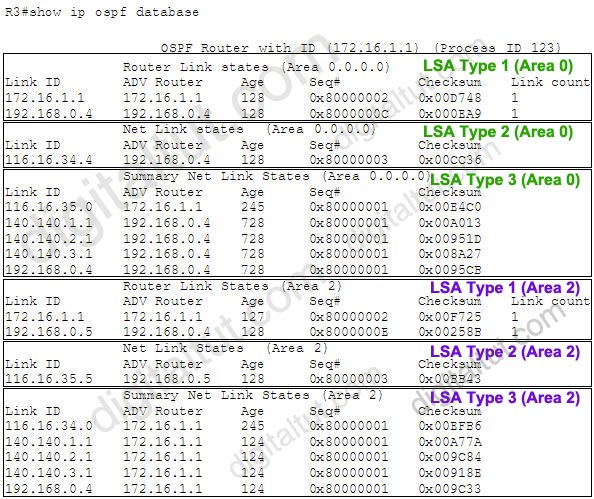



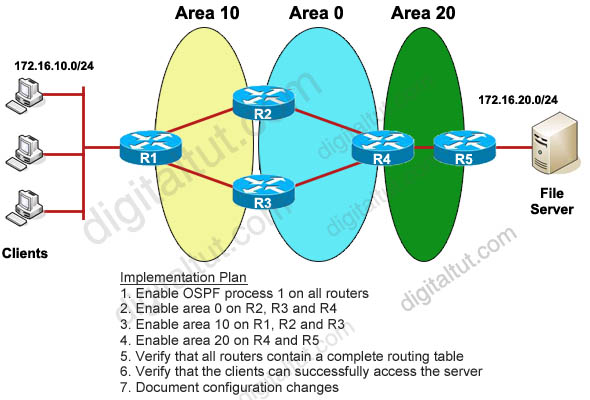
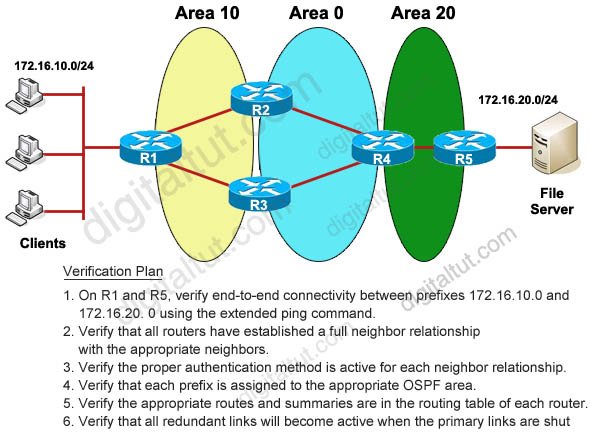
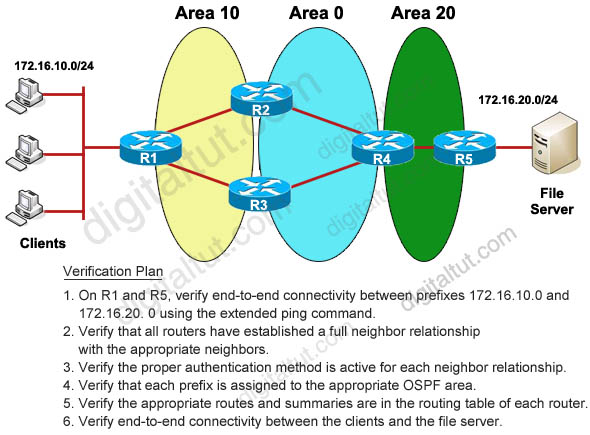
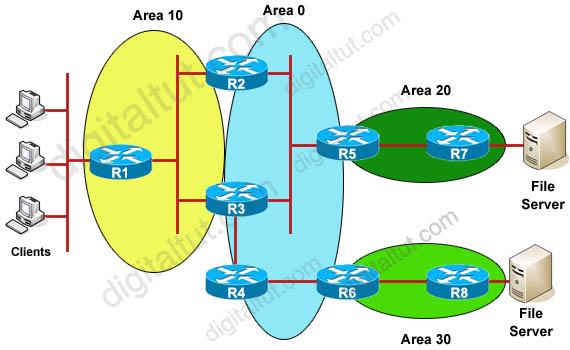
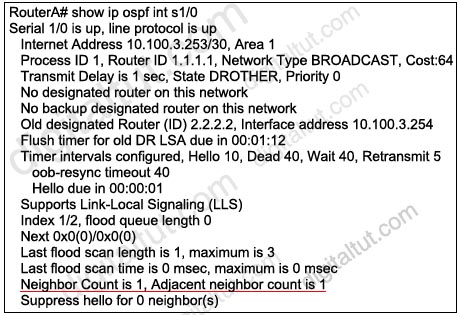
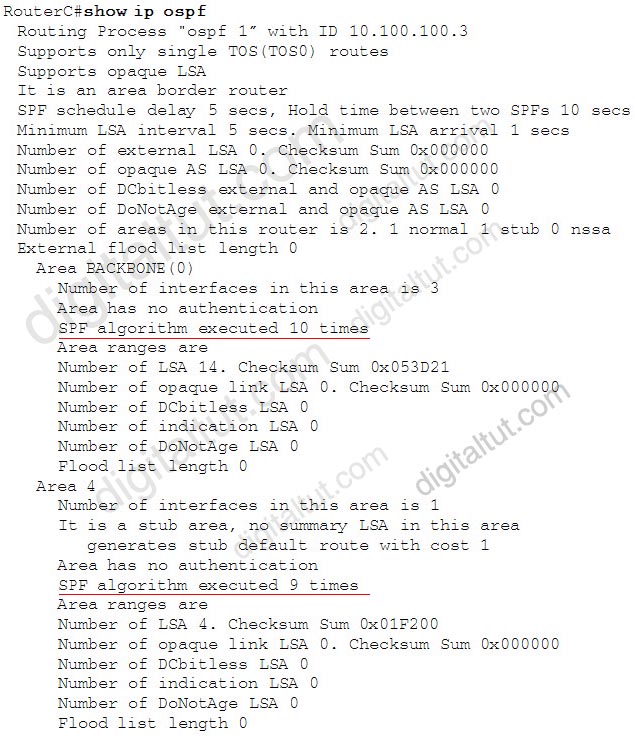
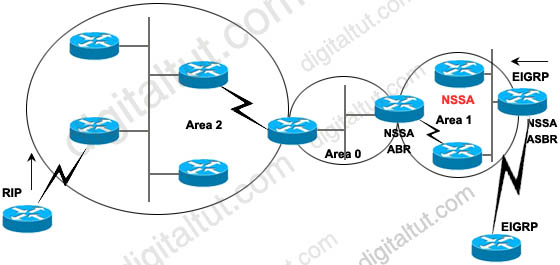
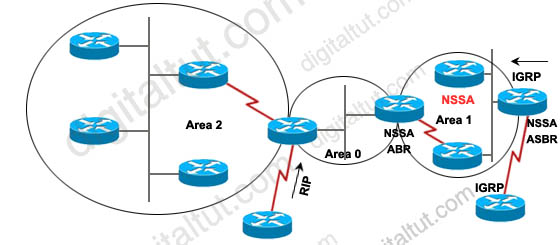
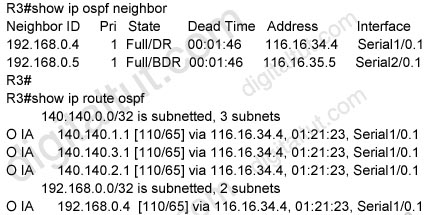
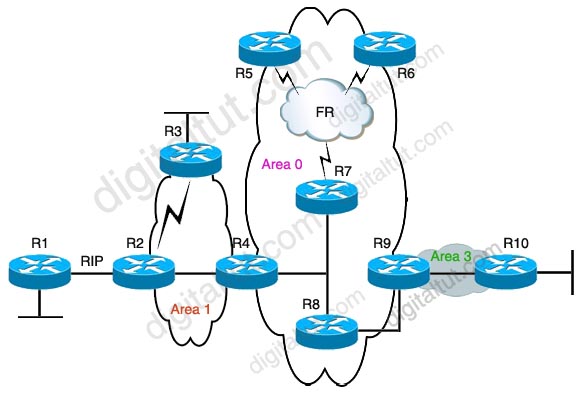
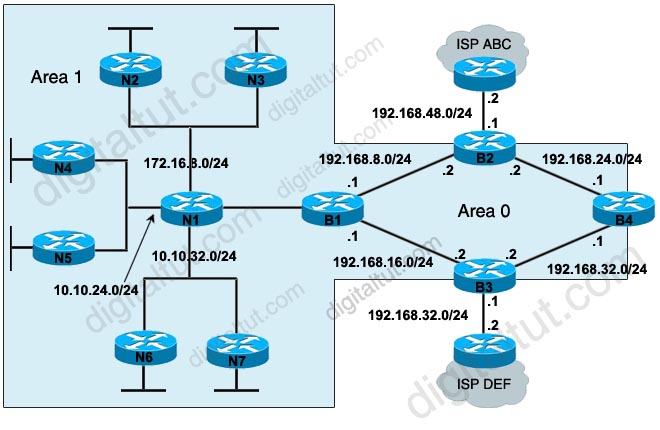
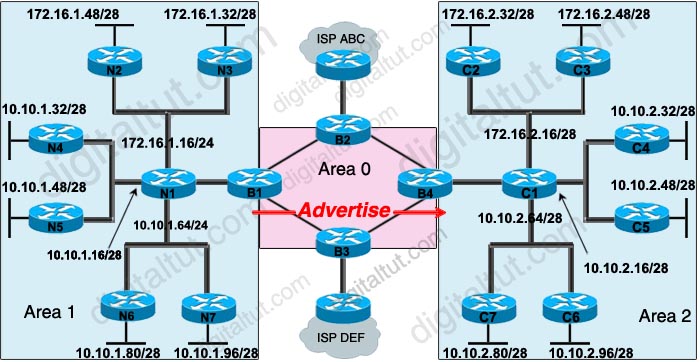
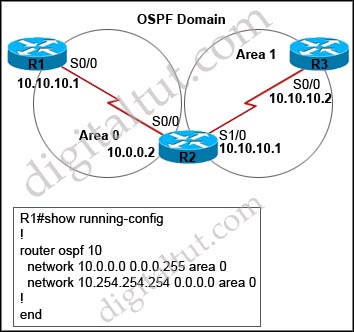

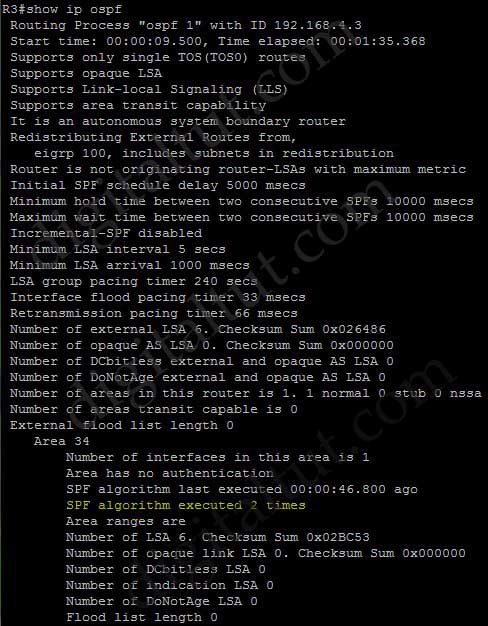
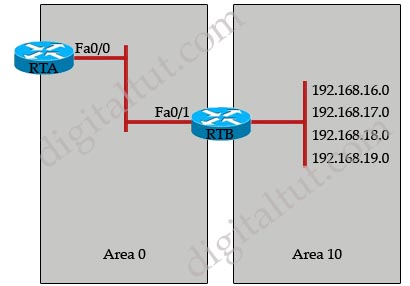
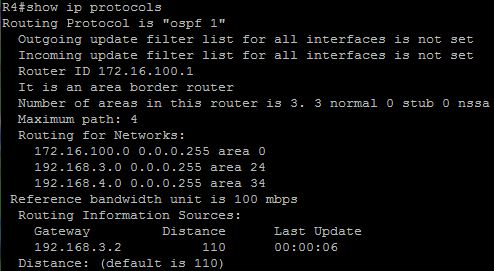
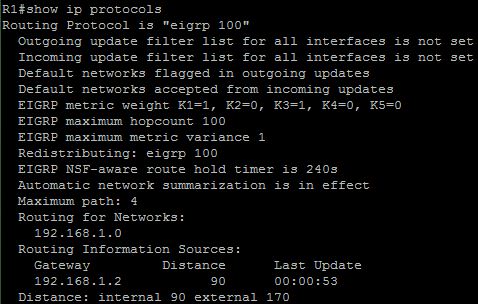
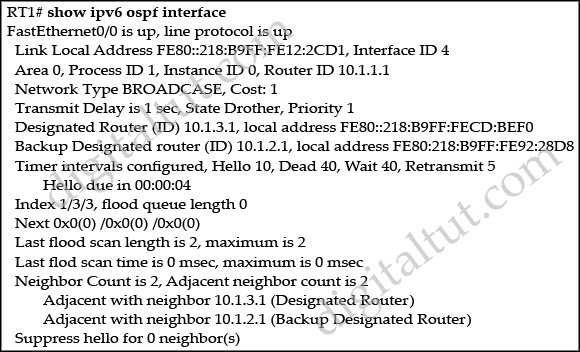
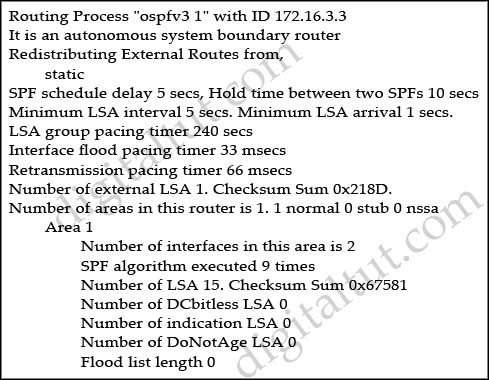
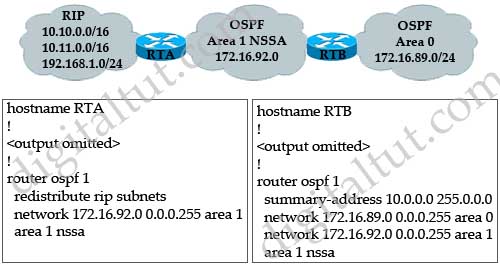
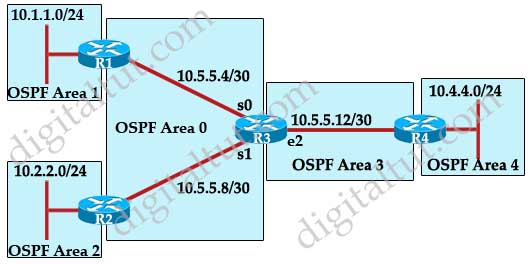

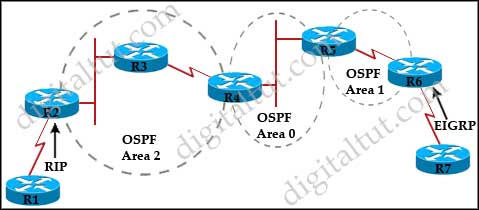
Comment